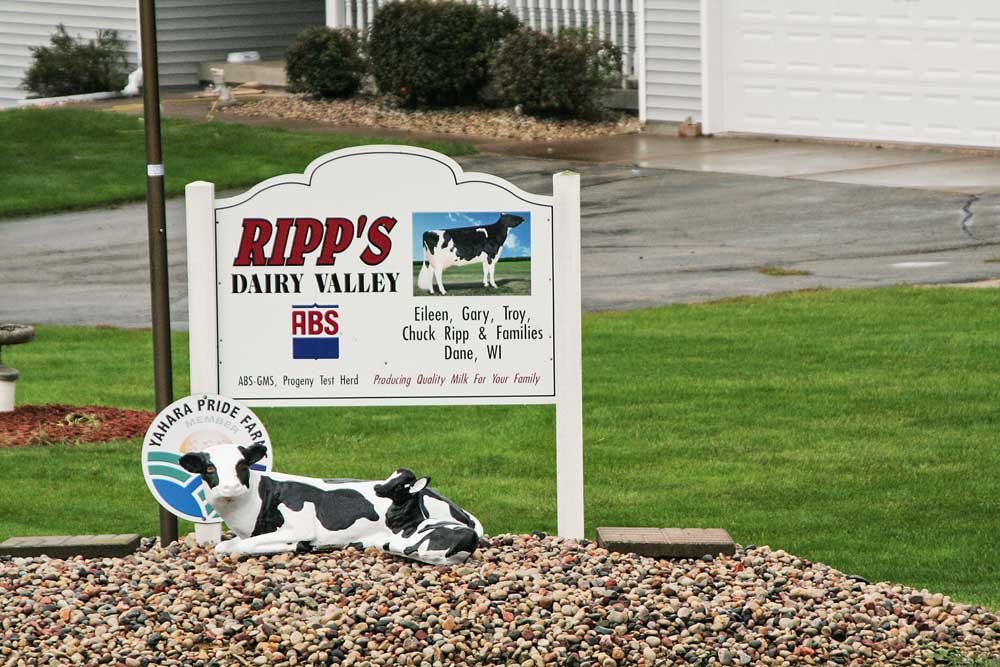Ripp’s Dairy Valley: Perfect conditions for high performance
By Sibylle Möcklinghoff-Wicke, Dairy Innovation Team
Sand bedded cubicles for all cows, ventilation fans and sprinklers supporting natural ventilation in the cow barns. On top of this, roofing is insulated to keep temperatures down in summer. The milking herd is grouped according to lactation stage or number. Feeding is once a day with the ration pushed-up eight times. Around 40 % of feed is bought in. In the insemination group, tail marking identifies in-heat cows. The successful service figure is well above average. Over 50 % of heifers are served with sexed semen and all cows are genotyped. Costs here are 44 €/animal, but the outlay pays: female and male breeding stock are regularly sold.
Jobs are shared out between the brothers
Gary is responsible for fieldwork, manure spreading and machinery maintenance. Additionally, he and his mother Ellen are in charge of the wages. Troy takes care of suckling calves and transit cows (three weeks before to three weeks after calving). Chuck looks after all documentation of cow data. Along with the breeding company, he’s responsible for cow fertility and arranging insemination. He also manages feed purchases.
In the transit barn the farmers work with a TCI (Transition Cow Index) that calculates and identifies early any fresh calving management mistakes. Each cow’s TCI helps comparison of actual milking performance and the output calculated as expected from breeding potential (TCI > 0 expectation exceeded, TCI ≥ 0 expectation not fulfilled). The Ripp family discovered that their herd TCI needed improvement, in that many cows at the beginning of their lactation did not achieve optimal performance and had various health problems. In order to give the animals the best possible start to their lactations, a new transit barn was built in 2008. Nowadays, average yield lies at over 14,000 kg. The herd barn features five rows of cubicles with central feed table. The double row cubicle positioning enables cow movement control from the feeding table. The aim: a quiet daily procedure for all the cows with all unnecessary distractions avoided as far as possible.
Organisation of the barn
- preparation group (TS 2) with cows brought into the building on a weekly basis, deep cubicles with sand bedding (127 cm broad and 3 m long), double-row cubicles; 76 cm cow feeding space, three calving boxes for »just-in-time« calving.
- dry period – over three weeks before calving (TS 1 in 3-row cubicle barn with insulated roof, ventilation fans over the cubicles, but no sprinklers.
Keeping the management simple
Calving boxes are adjacent to the cubicles for the TS2 group so that a calving cow can be moved into the calving quarters (with camera monitoring) immediately before birth, whereby the aim is not to take the cow any longer than 12 hours out of her group. After calving she has 20 minutes to lick her calf dry. During the dry period, all cows are driven three times a week through a footbath and all dry cows and late-gestation heifers are vaccinated one week before calving. Within the first hour after birth, calves are drenched with pasteurised colostrum (3.8 l), tested for para TB and then put into a single box with heating lamp.
Enough space for calves and weaners
A barn was built in 2006 for a total 108 calves and 85 weaners, offering plenty of space and enabling efficient working conditions. The calves get milk twice daily over a six to seven week period. Two PPT hoses bring in fresh air. So that every staff member knows which calf gets what milk and how much, a table hangs in the barn upon which different colours signify when each calf was born, whether it still gets colostrum or should receive other milk instead. After weaning, calves are grouped in fours and, after a few weeks, regrouped into pens of six or eight for housing in a two-compartment loose housing barn. Chuck Ripp explains: »While this is a fairly expensive barn with so much room for the calves, it gives us a real possibility of doing a good job«. This is confirmed by a rearing mortality of under 5 %. At around 6 months, the young stock move to a rearing farm, coming back home shortly before calving.




